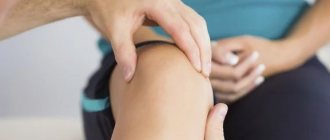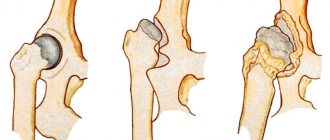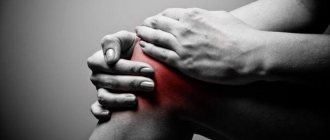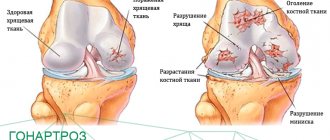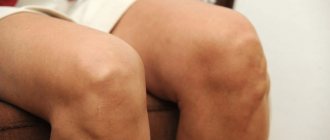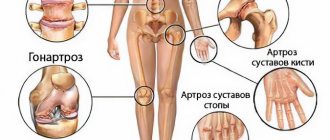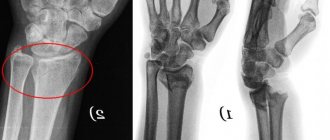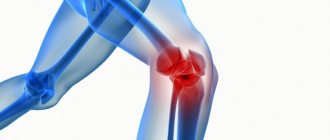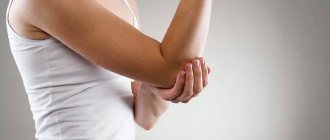Deforming osteoarthritis of the hip joint is a disease of older people, which is caused by degenerative processes of cartilage tissue. The progression of arthrosis of the hip joint is accelerated by the discrepancy between the articular surfaces, which leads to abnormal friction. In some patients, the disease develops due to ischemia of the femoral head after fractures of the femoral neck or direct damage to the articular cartilage; in 50% of cases the cause of the disease is unknown. Doctors at the Yusupov Hospital diagnose osteoarthritis of the hip joint using radiography and computed tomography.
Treatment of deforming arthrosis of the hip joint is carried out with the latest medications, which are highly effective and have minimal side effects. Professors and doctors of the highest category discuss severe cases of coxarthrosis at a meeting of the Expert Council and collectively make decisions regarding treatment tactics for each patient. Rehabilitation specialists use innovative methods of restorative therapy to slow down the progression of articular cartilage degeneration.
Signs of arthrosis of the hip joint
Patients suffering from deforming arthrosis complain of sudden attacks of stiffness in the hip joint, which appear after a state of rest and go away after some activity. Initially, attacks of minor pain continue for 1-2 days, intensifying after prolonged periods of weight bearing.
Protective lameness often occurs due to muscle spasm, which is accompanied by pain and a gradually increasing sensation of joint stiffness. Arthrosis of the left hip joint manifests itself with the same symptoms as arthrosis of the right hip joint. Pain with arthrosis of the hip joint is localized along the anterior or posterior surface of the joint, depending on the location of the inflammation. It radiates pain to the front and inner surface of the thigh and to the popliteal fossa. The pain syndrome intensifies after prolonged load on the limb and movements, especially in the direction of internal rotation, abduction, and extension. Patients often complain of increased pain in damp and cold weather and note relief in warmth and after taking acetylsalicylic acid.
In the acute period of arthrosis-arthritis of the hip joint, patients note pain over the site of inflammation of the capsule, which is accompanied by muscle spasm involving the adductor muscles of the thigh. Orthopedists perform a Faber test: the patient places the heel of the affected limb on the dorsum of the healthy foot and slides it up the skin of the tibial surface of the leg to the knee. It will be positive for any inflammatory process in the hip joint.
In the early stage of arthrosis of the hip joint, there are no changes on radiographs. Later, radiologists occasionally detect subchondral sclerosis, which gradually leads to a narrowing of the joint space. An additional sign is flattening of the head in its upper pole, which is accompanied by cystic changes in this area.
Postoperative recommendations
To prevent complications after surgery, it is important to follow a number of recommendations:
- Refrain from lifting and carrying heavy objects, watch your weight - extra pounds and loads create increased stress on the operated joint
- Choose comfortable, high-quality shoes with stable heels and non-slip soles
- Do physical exercise (in accordance with the load selected by your doctor). At the same time, long walks and climbing stairs are prohibited.
- It is not recommended to stand up abruptly, it is important to do it smoothly, leaning on your hands and armrest - this allows you to relieve the load on the operated joint
- You can't sit cross-legged
- It is important to promptly treat any inflammatory diseases; infection poses a threat to the operated joint
- It is not recommended to fly for 3-4 months (long-term forced position)
- During the rehabilitation period, it makes sense to use crutches, a cane, and chairs with armrests to reduce the load on the operated joint
- It is recommended to use orthopedic insoles and special braces
Degrees of arthrosis of the hip joint
As it progresses, deforming arthrosis of the hip joints goes through several stages, according to which three degrees of the disease are distinguished.
Deforming arthrosis of the 1st degree is the initial stage of the disease, when there are no obvious changes in the structure of the joint tissues. Pain syndrome is often absent, and if it does occur, it is due to the inflammatory process. Patients may complain of a feeling of stiffness and fatigue in the limb. Often the first degree of osteoarthritis of the hip joint is asymptomatic.
With grade 2 deforming arthrosis, morphological changes are obvious. The articular surfaces are uneven and contain significant bone growths. The bone tissue in the joint area becomes less strong. Due to the inflammatory process, the synovial membrane becomes greatly thickened. The pain can be dull, aching and last constantly, or it can occur sharply and abruptly.
In the case of grade 3 deforming arthrosis, the pain becomes so intense that it does not go away even after prolonged rest. Mobility in the diseased joint is reduced, and the axis of the limb may be disrupted. The cartilage tissue that covers the joint surfaces can develop ulcers and areas of decay.
Possible complications
- Tissue death.
- Protrusion (pushing) of the acetabulum.
- Spinal deformity (kyphosis and scoliosis).
- Knee arthrosis (gonarthrosis).
- Arthritis, bursitis (acute inflammation of joint tissue).
- Ankylosis (tissue fusion, complete immobility of the leg).
How to treat arthrosis of the hip joint
Doctors at the Yusupov Hospital carry out conservative treatment of arthrosis of the hip joint during exacerbation of the disease. It includes unloading the limb, traction, heat and massage. To reduce the inflammatory process, salicylates are prescribed. Glucocorticoid injections are given for grade 1 and 2 arthrosis of the hip joint. In the third stage of deforming arthrosis of the hip joint, the only effective treatment method is planned replacement of the hip joint with an endoprosthesis.
At the Yusupov Hospital, complex treatment of arthrosis of the hip joint is carried out using physiotherapy and kinesitherapy, and diet correction. Effective therapy for the initial stages of the disease allows people with grades 1 and 2 arthrosis of the hip joint to avoid endoprosthetics and limit the need for medications.
Diagnostics
The main method for diagnosing hip arthrosis is radiography. With its help, the degree of the disease is determined.
Sometimes, to determine the condition of the soft tissues, it is necessary to additionally undergo a CT or MRI.
Indicators of laboratory tests (general and biochemical blood tests, coagulogram - blood clotting test, urine test) for arthrosis remain unchanged.
However, with concomitant inflammation of the synovial capsule (reactive synovitis):
- the erythrocyte sedimentation rate (ESR) increases;
- the level of sialic acids and seromucoids (substances that indirectly indicate the presence of inflammation) increases.
Additional research methods: 1, 2 – radiography and MRI of the hip joints; 3 – blood test
Surgical treatment of deforming coxarthrosis
For grade 3 coxarthrosis, when conservative treatment does not bring relief, only prosthetics can relieve the patient of pain and discomfort, restoring the joy of movement. If there is fluid in the joint, it is pumped out after the puncture. Corticosteroid hormones are simultaneously injected into the hip joint.
With the help of arthroscopic debridement, the inner surface of the joint is cleaned from fragments of altered cartilage tissue and its cavity is washed with a medicinal solution to relieve the inflammatory process. Periarticular osteotomy is an artificial fracture of the femur followed by its fusion at a different angle. Surgery can reduce the load on the joint.
Prevention
To prevent arthrosis, it is necessary to take general health promotion measures:
- Adjust your diet with the help of your doctor.
- Lead an active lifestyle.
- Protect the joint from excessive stress.
- Don't get too cold.
- Avoid uncomfortable shoes.
To prevent further destruction of the joint with existing arthrosis, it is recommended:
- constantly engage in physical therapy;
- annually carry out sanatorium-resort treatment;
- repeat the course of therapeutic massage 2-3 times a year.
Rehabilitation methods for deforming arthrosis
To treat patients suffering from osteoarthritis of the hip joint, the following types of physiotherapy are used in the rehabilitation clinic of the Yusupov Hospital:
- shock wave therapy - exposure to sound waves that ensure blood flow to the desired area of the body, which stimulates regeneration processes and accelerates metabolism;
- myostimulation, which restores the function of muscles weakened due to forced restriction of movements in the joint;
- phonophoresis is a method that combines the advantages of ultrasound and medicinal effects on the body (under the influence of the device, a medicinal product in the form of an ointment or cream penetrates more effectively through the skin to the hip joint);
- ozone therapy – reduces discomfort and activates the growth of cartilage tissue due to the properties of the ozone-oxygen mixture.
Kinesitherapy is considered the basis for the successful treatment of arthrosis of any location. Regularly performing a special system of gymnastic exercises strengthens the ligaments and muscles around the joint affected by the pathological process, which reduces discomfort during normal daily activities. The exercise therapy instructor individually selects exercises for arthrosis of the hip joint of degrees 1, 2 and 3. Rehabilitation clinic specialists perform various types of massage, including lymphatic drainage, and use innovative manual therapy techniques aimed at passive work with muscles, ligaments and joints. The approaches used to help people with coxarthrosis by doctors at the Yusupov Hospital reduce the need for pills and injections for deforming arthrosis, which reduces the pharmacological load on the body.
The rehabilitation clinic is equipped with modern mechanical and computerized simulators from the world's leading manufacturers. They help to exercise the joint without significant physical effort, which is especially popular among older people. Traction of the joints using a special traction device or the hands of a chiropractor increases the space inside the joint, which “throws back” the pathological process several steps back, relieving symptoms and giving the body time to restore the function of the hip joint.
Dietary therapy is necessary for all patients with osteoarthritis of the hip joint, but is most important for people with excess body weight. Losing weight reduces the load on the inflamed joint and improves metabolism. In combination with other conservative methods, a balanced diet, which is provided to patients by the cooks at the Yusupov Hospital, allows you to forget about pain and other manifestations of arthrosis of the hip joint.
Gymnastics for arthrosis of the hip joint
Gymnastic exercises for arthrosis of the hip joint are not prescribed in the following cases:
- exacerbation of arthrosis-arthritis;
- recently undergone major surgery;
- in the presence of a hernia, acute diseases of internal organs;
- during menstruation;
- when body temperature rises above 37.50C.
The rehabilitator selects all exercises individually. The exercise therapy instructor takes into account the patient’s age, the severity of the pathological process and the presence of concomitant diseases. For deforming arthrosis, well-chosen gymnastics should put a useful load on the muscles and ligaments of the hip joint, but not on the joint, because it is already worn out.
A set of gymnastic exercises for arthrosis of the hip joint consists of a greater number of static exercises than dynamic ones. Static exercises are those where you need to fix the position of your body for a few seconds. If such movements are sufficient, the muscles and ligaments of the legs receive the necessary load to restore the joint. The hip joint itself takes minimal part in such exercises and does not wear out.
In order to undergo a course of treatment and rehabilitation of deforming arthrosis of the hip, call the Yusupov Hospital, where the contact center is open around the clock every day. You will be scheduled for an appointment at a time convenient for you.
Video
Arthrosis of the hip joint is a serious disease, the treatment of which is ineffective without creating an optimal physical activity regimen. The use of physical therapy is one of the main factors influencing the arrest of the development of the pathological process. The exercises in this case are static in nature. With their help, muscles are strengthened, blood circulation and cartilage nutrition are improved. The choice of exercises depends on the condition of the joint. We invite you to familiarize yourself with a complex of therapeutic exercises for performing at home:
Found an error in the text? Select it, press Ctrl + Enter and we will fix everything!
